Type Ia Supernova: Destabilized White Dwarfs Might Trigger Massive Stellar Explosions

Researchers and astrophysicists believe they have discovered a vital link in the understanding of stellar explosions, in particular the Type Ia supernova.
According to the new research by astrophysicist Rosanne Di Stefano and her colleagues from the Harvard-Smithsonian Center for Astrophysics, these cosmic explosions occur due to the activities of some old stars known as white dwarfs.
Apart from this, they also mentioned that these ticking time bombs could be scattered throughout our galaxy.
White dwarfs are the stellar remnants that have ceased nuclear fusion. Typically, these stars weigh up to 1.4 times as much as our sun - a figure called the Chandrasekhar mass after the astronomer who first calculated it. Any heavier, and gravity overwhelms the forces supporting the white dwarf, compacting it and igniting runaway nuclear fusion that blows the star apart.
We haven't found one of these 'time bomb' stars yet in the Milky Way, but this research suggests that we've been looking for the wrong signs. Our work points to a new way of searching for supernova precursors, said Di Stefano.
Two scenarios of such stellar explosions were presented by the researchers. According to the first explanation, a white dwarf may exceed the Chandrasekhar mass if it accretes gas from a donor star. The second scenario states that these explosions may be the result of two white dwarfs colliding.
Most astronomers favor the first scenario as the more likely explanation. But we would expect to see certain signs if the theory is correct, and we don't for most Type Ia supernovae.
For example, we should detect small amounts of hydrogen and helium gas near the explosion, but we don't. That gas would come from matter that wasn't accreted by the white dwarf, or from the disruption of the companion star in the explosion. Astronomers also have looked for the donor star after the supernova faded from sight, without success.
Di Stefano and her colleagues suggest that white dwarf spin might solve this puzzle. A spin-up/spin-down process would introduce a long delay between the time of accretion and the explosion. As a white dwarf gains mass, it also gains angular momentum, which speeds up its spin. If the white dwarf rotates fast enough, its spin can help support it, allowing it to cross the 1.4-solar-mass barrier and become a super-Chandrasekhar-mass star.
Once accretion stops, the white dwarf will gradually slow down. Eventually, the spin isn't enough to counteract gravity, leading to a Type Ia supernova.
Our work is new because we show that spin-up and spin-down of the white dwarf have important consequences. Astronomers, therefore, must take angular momentum of accreting white dwarfs seriously, even though it's very difficult science, explained Di Stefano.
© Copyright IBTimes 2025. All rights reserved.





















